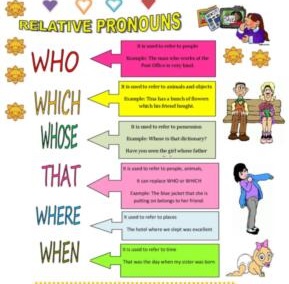Relative pronouns are used to connect a clause or phrase to a noun or pronoun. They introduce relative clauses, which provide additional information about the noun or pronoun. The most common relative pronouns are who, whom, whose, which, and that.
Types of Relative Pronouns
- Who
– Used to refer to people (as the subject of the clause).
– Example:
– The girl who won the prize is my friend.
(Here, “who” refers to “the girl” and introduces the clause “won the prize.”)
- Whom
– Used to refer to people (as the object of the clause).
– Example:
– The man whom you met is my uncle.
(Here, “whom” refers to “the man” and is the object of the verb “met.”)
- Whose
– Used to show possession (for people, animals, or things).
– Example:
– The boy whose bag was stolen is crying.
(Here, “whose” shows that the bag belongs to “the boy.”)
- Which
– Used to refer to animals or things (as the subject or object of the clause).
– Example:
– The book which I borrowed is very interesting.
(Here, “which” refers to “the book” and introduces the clause “I borrowed.”)
- That
– Used to refer to people, animals, or things (as the subject or object of the clause).
– Example:
– The car that I bought is red.
(Here, “that” refers to “the car” and introduces the clause “I bought.”)
Rules for using Relative Pronouns
- Who vs. Whom:
– Use who when the pronoun is the subject of the clause.
– Use whom when the pronoun is the object of the clause.
– Example:
– “The teacher who taught me is kind.” (subject)
– “The teacher whom I admire is kind.” (object)
- Which vs. That:
– Use which for non-essential clauses (clauses that add extra information).
– Use that for essential clauses (clauses that are necessary for the meaning of the sentence).
– Example:
– “The book, which is on the table, is mine.” (non-essential)
– “The book that I need is on the table.” (essential)
- Whose for Possession:
– Use whose to show ownership for people, animals, or things.
– Example:
– “The dog whose tail is wagging is happy.”
- Omission of Relative Pronouns:
– In informal English, relative pronouns like that, who, or which can sometimes be omitted if they are the object of the clause.
– Example:
– “The book (that) I bought is interesting.”
Examples of Relative Pronouns in sentences
- Who:
– The boy who is playing football is my brother.
- Whom:
– The girl whom you invited is here.
- Whose:
– The artist whose painting won the award is famous.
- Which:
– The laptop which I bought is very fast.
- That:
– The cake that she baked was delicious.
Remember:
- Whom, whose, who are used for persons.
- which is used for animals and non-living things.
- That is used for both things and animals.
Image Courtesy

















